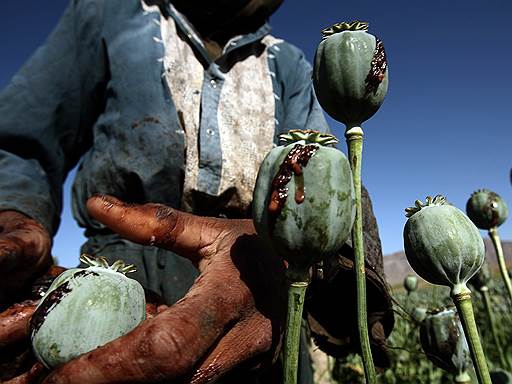A new UNODC report notes that area under opium poppy cultivation increased in Afghanistan by 63% since 2016, reaching a new record high.
The total area under opium poppy cultivation in Afghanistan was estimated at 328,000 hectares in 2017, a 63% increase or 127,000 hectares more compared to the previous year. This level of opium poppy cultivation is a new record high and exceeds the formerly highest value recorded in 2014 (224,000 hectares) by 104,000 hectares or 46%.
Strong increases were reportedly observed in almost all major poppy cultivating provinces. In Hilmand province alone, cultivation increased by 63,700 hectares (+79%) which accounted for about half of the total national increase. Strong increases were observed also in Balkh (+10,000 hectares or almost five times more than in 2016), Kandahar (+7,500 hectares or +37%), Nimroz (+6,200 hectares or +116%), and Uruzgan (+6,000 hectares or +39%).
The majority (60%) of cultivation took place in the south part of the country. The western region accounted for 17% of total cultivation, the northern region for 13% and the eastern region for 7%. The remaining regions (North-eastern and Central) together accounted for 3%. Hilmand remained the country’s major opium poppy cultivating province, followed by Kandahar, Badghis, Faryab, Uruzgan, Nangarhar, Farah, Balkh, Nimroz and Badakhshan.
Opium poppy cultivation expanded to new regions and intensified where there was cultivation before. In 2017, the number of poppy-free provinces in Afghanistan decreased from 13 to 10. The number of provinces affected by opium poppy cultivation increased from 21 to 24.
Opium poppy cultivation intensified in the main opium-poppy cultivating provinces by holding a more significant share of the available agricultural land.
Total eradication of opium poppy increased by 395 hectares but remained very low. In 2017, 750 hectares of opium poppy were eradicated in 14 provinces (355 hectares in 7 provinces in 2016). During the 2017 eradication campaign, six lives were lost and eight persons were injured. In 2016, eight lives were lost and seven persons were injured.
Potential opium production was estimated at 9,000 tons in 2017, an increase of 87% from its 2016 level (4,800 tons). The increase in production is mainly a result of an increase in area under opium poppy cultivation, while an increase in opium yield per hectare also contributed.
In 2017, the average opium yield amounted to 27.3 kilograms per hectare, which was 15% higher than in 2016. Yields increased in the Southern region by 19% (from 22.0 kilograms per hectare in 2016 to 26.2 kilograms per hectare in 2017), in the North-eastern region by 14% (from 31.2 to 35.4 kilograms per hectare) and in the Eastern region by 8% (from 32.4 to 34.9 kilograms per hectare). In the Central and Northern regions, yields decreased by 5% and 6% respectively and remained stable in the Western region.
Accounting for 57% of national production, the Southern region continued to produce the vast majority of opium in Afghanistan. With 16% of national production, the Northern region was the second most important opium-producing region in 2017, followed by the Western region (13%) and Eastern region (9%).
In response to the increased supply of opium, 2017 prices at harvest time decreased in all regions (between -7% in the Western region and -50% in the North-eastern region) of Afghanistan except in the Southern region where prices only dropped in the months after the harvest.
At almost US$ 1.4 billion (1.2 – 1.5 billion), equivalent to roughly 7% of Afghanistan’s estimated GDP, the farm-gate value of opium production increased by 55% in 2017 as compared to past year.
The report says there is no single reason for the massive 2017 increase in opium poppy cultivation in Afghanistan. The multiple drivers are complex and geographically diverse, as many elements continue to influence farmers’ decisions regarding opium poppy cultivation.
Rule of law-related challenges, such as political instability, lack of government control and security, as well as corruption, have been found to be main drivers of illicit cultivation. Also impact farmers’ decisions, for example scarce employment opportunities, lack of quality education and limited access to markets and financial services continue to contribute to the vulnerability of farmers towards opium poppy cultivation.







